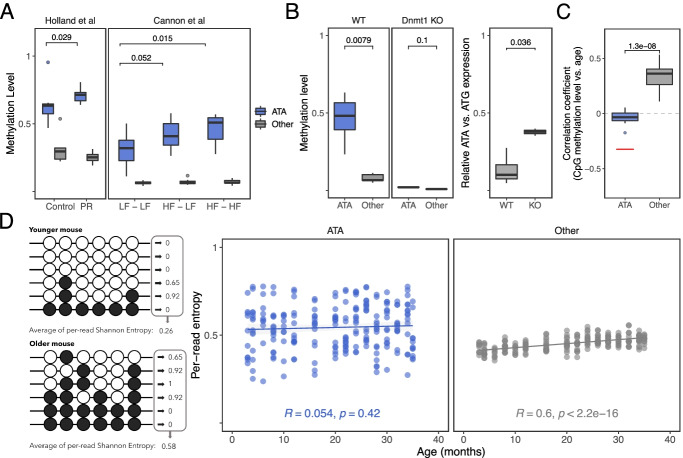Fig. 3.
Epigenetic dynamics at C57BL/6J rDNA haplotypes are life-stage specific. A Hypermethylation of the ATA haplotype (blue) is observed in different models of in utero stress paradigms; the other three haplotypes (gray) are combined into a single category since they show similar effects. Methylation levels for ATA and non-ATA haplotypes for all panels are obtained on the CpG sites associated with the SNVs at 6007 and 6832. PR, LF, and HF stand for protein-restricted, low-fat, and high-fat diet, respectively. All animals from Holland et al. [6] were fed control diet post-weaning. The labels for Cannon et al. [16] denote the pre-weaning, post-weaning diet combinations. B In Dnmt1 KO 8.5dpc embryos from Dahlet et al. [17], the ATA haplotypes lose methylation in RRBS data (left panel) and display de-repression of ATA haplotype rRNA expression (right panel). Both ATA and ATG expression are obtained from ITS2 variants to avoid differential rRNA depletion effects. C In RRBS data from Petkovich et al. [18], aging-associated DNA hypermethylation is observed only at non-ATA haplotypes. The red line indicates the expected correlation coefficient for ATA haplotypes if they lost methylation at the same rate as the non-ATA haplotypes gain methylation. In this study, in the 3-month-old mice, the average methylation at ATA was ~ 75% and at non-ATA haplotypes was ~ 25%. D Only non-ATA haplotypes display increasingly disordered DNA methylation profiles with age (right panel) in RRBS data from Petkovich et al. [18]. Disorder is estimated as the average of per-read Shannon entropy (left panel—example from two hypothetical mice)

